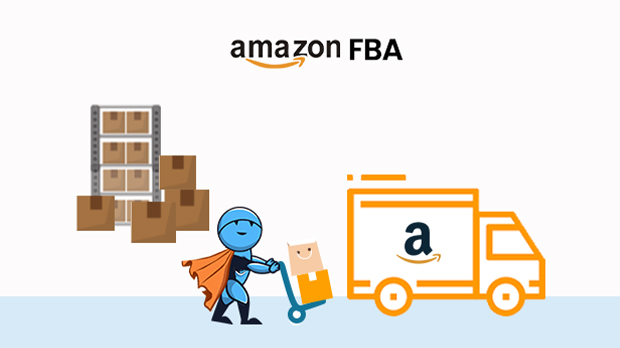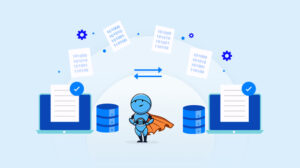Amazon, being the largest e-commerce platform, is continually growing. Amazon has been making strides over the past few years to be the one-stop-shop for building a brand and converting customers with an impressive success rate to engage with customers at all stages of the funnel and is currently working with more than 9.7 million sellers worldwide, of which 1.9 million register sales and have been actively selling on the marketplace. In addition, sales for independent businesses selling on Amazon grew exponentially, offering new opportunities to earn money online.
In 2006, Amazon introduced the Fulfillment by Amazon (FBA) service to simplify logistics for merchants and buyers. Since then, it has exploded in popularity, giving a solution to fulfillment and customer service issues and opening the door to a vast fulfillment network.
The plan was to incorporate Amazon’s current fulfillment model into the procedures of third-party sellers so that those sellers, in turn, could use this infrastructure to serve Amazon’s clientele. Not only would Amazon vendors benefit significantly from the addition of this feature, but so would users of this massive Amazon marketplace because of the improved speed and dependability of shipment and customer support.
This post will provide an overview of Amazon FBA and how you can utilize it to improve operations that will help you grow sales and promote brand awareness while you sell on Amazon.
What is Amazon Fulfillment by Amazon (Amazon FBA)
The fulfillment by Amazon (FBA) program allows merchants to outsource their inventory management, order processing, shipment, and return handling to Amazon in exchange for a fee. As an online retailer, you may find FBA to be a helpful service. But it comes at a price, of course.
Amazon’s global storage and delivery capabilities make Amazon Fulfillment a great service. The largest online retailers may use the platform’s architecture and scalability.
Sellers registered under the Fulfillment by Amazon program can sell their products on this platform, and Amazon will fulfill the inventory.
Sellers can ship their products directly to the fulfillment center of Amazon. It is a warehouse where all the products are stored. Whenever any customer makes an order with Amazon, it will be the responsibility of Amazon’s team to pick, pack, and ship the products to the desired destination.
With Amazon FBA, sellers need not worry about storing or shipping their products. All they need to do is monitor their inventory and focus on framing strategies for marketing and optimizing their listings.
What are the benefits of Amazon FBA
Research shows that more than half of GSIs make use of Amazon FBA. At the same time, a whopping 66 percent of the top 10,000 Amazon sellers depend on Amazon to handle all of their order fulfillment needs. These numbers demonstrate the service’s high value and popularity. The benefits of joining Amazon’s Fulfillment by Amazon program are outlined below.
Superior Logistics and Storage Capabilities
As an FBA member, you’ll have access to Amazon’s extensive network of state-of-the-art distribution facilities, semi-trailer trucks, airplanes, helicopters, cargo ships, and drone aircraft.
With tens of thousands of full-time employees and a fleet of robots, Amazon operates one of the most sophisticated fulfillment networks in the world. You may use Amazon’s world-famous facilities, employees, and knowledge gained over many years.
Shipping is Fast and Free
Customers who buy things online adore fast and free shipping.
That fact did not escape Amazon’s attention. So they made expedited shipping an option when they first introduced Prime. Interesting fact: Amazon was the one who came up with the idea of overnight shipping. Prime members may take advantage of several expedited shipping options, including same-day delivery, one-day shipping, and two-day shipping with Prime Now 2-Hour Delivery. This is thanks to the online retailer’s careful placement of fulfillment centers worldwide and the hiring of tens of thousands of FBA workers, especially around the holidays and during specials.
Amazon is quite proactive when it comes to meeting the needs of its online customers. If you haven’t heard, the COVID-19 outbreak last year caused both stores to declare bankruptcy.
Prime-eligibility Guaranteed
Fast and free shipping is a significant selling point of Amazon Prime, and customers rely significantly on it. These folks will splurge for Prime’s expedited shipping and other benefits.
Statista reports that annual spending by Prime members is $1400. Compare that to the $600 non-Prime members pay yearly, and you’ll see a big difference. 81% of Prime members are between the ages of 18 and 34, the prime spending years of today.
So, if you’re hoping to sell to this kind-hearted audience, signing up for Amazon FBA is your best choice for gaining rapid access to the Prime Shipping program and opening the door to the Prime Buyer demographic.
This perk makes selling on Amazon FBA much more worthwhile. There is intense competition for the Buy Box located on every product page. It’s the part of the site where people may rapidly throw things in their carts.
All merchants cover the Buy Box since it increases revenue. If you’re a Prime member, you have a better chance of getting the Buy Box.
Learn more about Amazon Buy Box.
Find Affordable Shipping Options
Amazon has worked with several shipping companies, including UPS, USPS, FedEx, and DHL Express. The shipping prices offered by these firms to Amazon are typically significantly reduced.
As an FBA seller, Amazon takes care of shipping fee negotiations on your behalf. In addition, dependable courier services will handle your packages.
Effortless Scalability
Nonetheless, that’s not all! You don’t need to spend time crafting a strategic strategy to rapidly expand your company’s reach. Here are some of Amazon’s FBA programs that you may “bolt on” to your present business model:
- With FBA Subscribe & Save, you can give your regular customers a discount on select FBA items.
- Reduced fulfillment costs for FBA merchandise that is tiny, light, and inexpensive thanks to FBA’s “Small & Light” program.
- With FBA Export, you can ship internationally to over a hundred countries at no extra cost to you.
- Let Amazon handle distribution and sales in all European markets at no additional cost and in record speed with FBA Pan-EU.
- With Amazon’s Multi-Channel Fulfillment program, you may sell your wares on both Amazon and other online marketplaces. Plus, they’ll handle picking, packing, and shipping to your clients.
How does Amazon FBA work
You make the sales, and Amazon fulfills and ships them for you. You can rely on the shipping and logistics services offered by your online store, but they will charge you a fee. Below is an overview of the entire Amazon FBA process:
- In this case, the seller ships goods to Amazon’s warehouses.
- When items are shipped to an Amazon fulfillment center, the company handles the reception, organization, and storage of the goods.
- On the market, the buyer purchases the vendor’s wares.
- Amazon handles all aspects of order fulfillment.
- Support inquiries will be answered by Amazon.
- Amazon also handles product returns if the consumer decides to do so.
What does Amazon FBA New Selection Program offer
Amazon’s FBA New Selection Program is a no-risk incentive for existing sellers to expand their product offerings and for new sellers to join the marketplace.
The following perks await your product if it is brand new on Amazon:
- For a period of three months, monthly storage expenses are waived for up to fifty units.
- You have 180 days to delete any of the 50 units at no cost.
- Apparel, footwear, accessories, jewelry, luggage, and watches are all eligible for free return processing.
- In essence, you get access to free 90-day storage for your purchases. Benefits from the FBA New Selection program per stock-keeping unit (SKU) are likely to be less than $100, but any amount is better than none.
In addition, new sellers can receive up to $100 in complimentary shipping credits to use with our partner carriers (to send your stuff into Amazon).
FBA New Selection Program offers the following benefits to the sellers:
Oversize Item Eligibility
Amazon offers free storage (for 90 days) and free removals (for 180 days) on the eligible oversize items (up to 30 units per parent ASIN – Amazon Standard Identification Number) under this program.
Sponsored Advertising
Promotional credits for the sponsored advertisements can be provided.
Sponsored Ad Promotional clicks will get $200.(New FBA sellers only)
ASIN Limit
Amazon declared that it would allow an unlimited number of eligible, new-to-FBA parent ASINs under the FBA New Selection Program leading to the removal of the 500-ASIN limit.
These advantages are available to program participants for the creation of up to 500 additional Amazon ASINs every calendar year. Every year on January 1st, the 500 ASIN cap will be recalculated. This needs your undivided attention. There will be no elimination of ASIN restrictions through the FBA New Selection initiative. The aforementioned language only signifies that you are permitted to add 500 new goods to the FBA New Selection program.
What is Amazon FBA Small and Light
Amazon FBA Small and Light is a programme that provides sellers with lower fulfilment fees for small, lightweight, and low-cost items. Products that meet the Small and Light program’s eligibility standards include:
Products weighing less than one pound
Products with a total dimension of 16 inches or less
Products with a price tag of $7 or less
The Small and Light programme has two fulfilment cost options:
For products priced at $5 or less, the order handling cost is $0.80 per order.
Order processing fee: $1 per order for products priced greater than $5 but less than $7.
Sellers that use the Small and Light programme must pay a $0.15 per-unit fulfilment fee in addition to the order handling fee.
If you sell small, cheap, and fast-moving products, the Small and Light programme is a terrific method to cut fulfilment expenses. The savings can be substantial, especially for things costing under $5.
It is crucial to remember, however, that the Small and Light programme has some limits. Products registered in the Small and Light programme, for example, are not eligible for Amazon Prime shipment. Furthermore, the Small and Light programme is not offered in every country.
Overall, the Amazon FBA Small and Light programme is a fantastic alternative for sellers wishing to save money on fulfilment for small, inexpensive, and fast-moving items. However, before deciding whether the programme is ideal for you, you should balance the advantages and downsides.
Amazon FBA Fee Structure for 2023
Amazon has indicated that beginning in 2023, FBA costs will change. After January 17, 2023, all items sent to American Amazon warehouses will be subject to the additional costs. Total FBA expenses are rising, with the following items standing out in particular:
- In regards to referral fees, nothing has changed.
- Recently implemented fuel surcharge will be incorporated into FBA fees, as will the inflation surcharge.
As of January 17th, 2023, the fuel and inflation surcharge of 5% will no longer be added to the base rate.
Price Reductions for the Redesigned Selection Process
- Fees for Amazon’s Mini and Light programs have been lowered as the company raises the threshold for qualifying goods from $10 to $12.
- The average FBA Outbound Fee has increased by $0.22.
- Finer-grained pricing for FBA international shipments
- The new date of February 16, 2023 has been set.
Price Increases for Disposal and Storage
- The cost of storing things has gone up by around 10%.
- Costs for storing items for 6 months or longer have been reinstated.
- Costs of Dissolution Have Not Changed
Fees for processing apparel returns have been reduced.
Fees for returns of apparel and footwear have been reduced by an average of $0.20.
Amazon FBA Clothing Fees in 2023
Shipping weights for regular products weighing more than 0.75 pounds and oversize, with the exception of special oversize, shall be determined by the larger of the item’s unit weight or its dimensional weight. Large standard-size and oversize units, with the exception of special oversize, will have their shipment weight determined by whichever is greater: the unit weight or the dimensional weight, beginning on February 16, 2023.
Substantial Price Increases for Delivering Hazardous Materials
Starting January 17, 2023, Amazon will start charging a charge for shipping hazardous materials in the United States through its Fulfillment by Amazon service. Dangerous items, commonly known as hazardous materials or hazmat, are subject to additional fulfillment fees from FBA.
Knowing how your profit margins will be affected by the FBA fee rise is the first step in being ready for the hike. You’ll need to recalculate your net profit margin to account for the additional FBA fees.
In the event of a price rise, Amazon sellers should evaluate their individual ASINs’ profitability, product pricing, and desired margins.
What is the procedure to become an Amazon FBA Seller
The steps you should follow to enroll in this program are:
- Select a niche
- Find products to sell on this platform
- Search for the product’s suppliers or manufacturers
- Establish your brand
- Sign up for an FBA seller account
- Create the product listings
- Prepare the products for packaging
- Ship the products to Amazon
- Launch and market your products
Select a Niche
Now that there are different requirements and restrictions as specified for the FBA products compared to the non-FBA ones, the sellers or businesses need to choose a niche after proper research. In case you fail to comply with selecting the appropriate niche, it can result in the following:
- Return or dispose of the inventory after reaching Amazon’s fulfillment center.
- Amazon can block your future shipment.
- You must pay a fine for noncompliance.
- Amazon can also deactivate your selling account.
You must choose among multiple niches, but it is always best to choose one specific niche. The most appropriate way to select the niche is to opt for the area you want to pursue most and are enthusiastic about.
Find Products to Sell on Amazon FBA
Now that you have determined the niche you have to work in, it is time to search for the products you can sell within the selected niche. Here are the tips you can consider while selecting the products:
- Consider choosing the small and lightweight products requiring minimum handling and shipping charges as both sizes, and weight of the products are evaluated while calculating the handling and shipping charges.
- Opt for generic products that can be easily rebranded.
- Do not go for seasonal products. Choose the ones you can sell all year-round.
- The products can get a patent at a later stage so that you can easily own their rights.
Search for the Product’s Suppliers or Manufacturers
Once you have selected the niche and products you are going to sell on Amazon; you must look for the suppliers or manufacturers that can provide you with qualitative products. It is necessary to look for these characteristics in suppliers or manufacturers:
- The manufacturer must have an efficient production system so that there is a consistent manufacturing process.
- The suppliers or manufacturers you are going to choose must follow the rules and regulations as specified by Amazon.
- The suppliers must welcome third-party inspection to make sure that the products are qualitative.
After you select the product manufacturers, evaluate the products. Ask for the samples so that the quality of the products meets the specifications.
Establish your Brand
Products you are going to sell on Amazon need an identity or face. Therefore, your next goal should be to produce a recognizable and identifiable brand. Here are steps to create a unique brand:
- Name the brand: When naming your brand, consider the future goal of your business, covering both your current as well as future business plans. The most suitable brand name for your business can be set after searching on Google for an appropriate Brand name, and you can pick the most suitable one for your business.
- Create brand design: A brand logo is necessary as it will go with the images of the products and items. The brand logo chosen must be simple enough to remember. Pick the brand color and attractive tagline apart from the brand logo.
- Registering the brand name and logo: Once the brand name and logo are set, the next step is to get them registered.
Sign up for an Amazon FBA seller account
To sign up for an FBA seller account, you must first have an Amazon seller account and then follow the steps given below:
- Tax information
- Active credit card
- Government ID
- Business email address
- Amazon Seller Business account number
- Amazon Seller Business email address
Now you are ready to choose the right Amazon seller plan to suit the strategies and goals of your business. You can either go with an individual plan or a professional plan.
Create the Product Listings on Amazon
4 steps to create your product listing on Amazon:
- You must visit ‘Amazon Seller Central.’ Then click ‘Add Product’ displayed under the inventory drop-down menu.
- Select ‘Create a New Product Listing’ and select the product category you will deal with.
- Next, you must fill in the necessary details, including the title, description, brand, manufacturer, price, and UPC of the products (Universal Product Code).
- Finally, you can click on ‘Save and Finish.
Prepare the Products for Packaging
After you create a product listing, now is the time to pack your products and ship them to Amazon’s warehouse. Remember that Amazon is very meticulous and, thus, has laid down rules for packaging its products. You need to follow the same when packing products.
Packaging and Preparation Requirements:
Each FNSKU (Fulfilment Network Stock Keeping Unit) must be packed in a single package, such as a polybag or box. In case the final product requires the assembly of different pieces, all pieces should be packed in one box. Amazon does not accept products requiring the assembly of multiple separate pieces at their dock.
Clubbing multiple FNSKUs (Fulfilment Network Stock Keeping Units) in a single polybag in a shipment may lead to receiving errors if not labeled correctly. If a carton contains multiple unique FNSKUs, ensure that the FNSKU label on each unique listing label is visible.
Go to the categories under ‘Packaging and Prep Requirements’ on the left-hand side to ensure that your products are prepped correctly.
If your ASIN is a pack of units, then ensure that only one FNSKU label is present. For example, if your ASIN is a pack of 3 bottles, then there should only be one FNSKU label (links to this ‘pack of 3’ ASIN) visible for the entire pack.
You must affix a single printed MRP label to each unit of the product, and the label must have all the existing details needed for products that require MRP labels. A single combined MRP label would suffice on the outermost package in the case of combo packs.
In the case of ASINs weighing less than 10 kg, it is a good idea to tie them together (with the help of tape) and packed inside 5 plied corrugated boxes.
As with ASINs weighing more than 10 kg-dumbbells, they must be packed in 5 plied corrugated boxes & next be packed by a woven sack.
You must affix with “Heavy lift with care” label on the four sides of the box.
The seller must use any FNSKU (Fulfillment Network Stock Keeping Unit) that will correspond to one unique product, including assortments, as each assortment type should have a unique FNSKU.
On the outside of each shippable unit of the product, all products must fulfill labeling with a proper scannable FNSKU (Fulfillment Network Stock Keeping Unit). The UPC, ISBN, or EAN numbers must be clearly readable by humans and should be included on the label. The product must have the Label on the exterior, which should be in an easily accessible and scannable location.
Make sure that there are no Multiple Scannable Barcodes (MSB). If there are MSB, then Amazon may charge you for this defect under the label issue.
For FBA or box labels, make sure you use A4 size paper, the right printer, and ink quality to avoid rejection or delays while onboarding at the fulfillment center.
If you do not have a thermal printer that can print on A4 size papers, then use a LaserJet printer and make sure that the quality of ink keeps the barcode intact.
Sellers should use sticky sheets as the paper quality is of a high standard and impressive. If you do not have access to sticky paper, you should make sure that the FBA label is covered neatly with transparent tape so that the barcode is intact and in good condition. Price tags, pamphlets, or other non-Amazon stickers are prohibited as they are considered unauthorized marketing materials. Amazon won’t accept pre-priced labels and such products.
Please go to Unplanned FBA Pre Services to avoid unplanned prep and package-related defects.
Safety: There should be adequate safety measures to be taken by you as you should use safety knives with covered blades when packing and distributing Amazon deliveries, sharp objects, such as blades if accidentally left in products and cartons, are liable to cause injuries to Amazon customers and Amazon Associates.
Sharp or hazardous, or damage-prone items: Sharp hazardous, or damage-prone items: Amazon makes it a point to highlight specifications regarding certain products that need additional packing requirements. Amazon reserves the right to mention additional protective packaging throughout the fulfillment process to preserve the integrity of the product.
Products sensitive to dust, dirt, or humidity need extra protection by packing in transparent poly bags. If such a product having these attributes is delivered to the Amazon fulfillment center with insufficient or inadequate or non-compliant packaging subjected to outright refusal and must be repackaged by Amazon at the seller’s expense and are likely to be subjected to non-compliance fees.
Ship the Products to Amazon
After packing, it is time to ship your products, and for this, you need to create a shipping plan, print the shipment ID labels as specified by Amazon, and ship the products to Amazon’s fulfillment centers. It is Amazon that determines the warehouse where your products should be shipped.
Launch and Market your Products
Lastly, you need to produce an effective marketing plan to launch your products in the market. Here are the key steps that will help you launch your items with a bang.:
- Optimize your product detail page
- Create a buzz using off-Amazon advertising.
- Set up Amazon PPC campaigns.
- Try to collect organic reviews
- Launch your products on Amazon.
What are the New Fee Changes for 2023 for FBA
On June 18, 2022, Amazon FBA fees were restructured across all categories of products:
- Up to 7.5% increase for small standard-size items
- Up to 2.8% increase for small oversize items
- 12.1% & 7.8% increase for medium & large oversize items
- Approx. 10% increase for apparel items
Although some of the fulfillment fee increases may seem small, these changes could put some sellers in tough positions and at risk of a decline in sales, especially if you’re already dealing with thin margins.
Recent Storage Fee changes by Amazon for a month
Effective from February 1st, 2022, Amazon is contemplating increasing off-peak monthly inventory storage fees, which will be applicable from January to September onwards. Amazon Storage Fee will be set as $0.08 per cubic foot for standard-size products, whereas $0.05 per cubic foot for oversize products as they are revised during 2022.
Limitations of Amazon FBA
The primary barriers you will face with FBA are those associated with the price of the service. Let’s have a look at the cons of FBA.
Storage Fees can Run Up
You may overstock Amazon’s fulfillment centers with your items if you launch your eCommerce business as a seller utilizing FBA without first gauging the inventory turnover. Because of this, your storage costs may rise, cutting into your profits.
Confronting Margin Pressure
While FBA is convenient, Amazon’s service fees will cut into your profit margins. As a result, your company’s profit margins will be under more stress than before.
Loss of Control over Returns
If you decide to have Amazon handle your return, you won’t be able to physically inspect the object before deciding whether or not to keep it. As a result, you learn less about why a service or item was deemed inadequate. You also have no recourse against such refunds.
Is Amazon FBA a Good Fit for your Business
Every retailer would rather have FBA handle their warehousing, shipping, and return needs instead of them. However, the service does not come without a price, and if you aren’t cautious, your profit margin might be eaten up by administrative, marketing, and servicing costs. We’ll go over the scenarios where FBA is the best option for you
Evaluate your Progress in Terms of a Scale
You have found some degree of success selling your items on Amazon and are now trying to take things to the next level. Using Amazon FBA is a fantastic method to expand your business and reach even more customers. By relieving you of the burdens of inventory management, shipping constraints, and customer service, Amazon FBA improves the efficacy of your business. Because of FBA, such capabilities may be adjusted as needed and scaled indefinitely.
Your conversion rate will increase since customers will be more likely to buy your items because they will be eligible for Amazon Prime if you sell them through FBA. Thus, sales will increase, and progress will quicken.
Get through Storage Constraints
Warehouse space constraints are one of the obstacles that merchants may face. Amazon’s huge network of fulfillment centers means it can hold an almost infinite quantity of your goods.
You should still be mindful of the expenditures of stocking up and storing your goods. Costs are simply relocated, and efficiencies are gained via the use of FBA.
Pay Attention to Sales and Advertising
If you have Amazon handle your fulfillment, you can rest assured that your customers will be completely satisfied. Put Amazon to work in your garden so you can focus on what you do best. That’s product management, marketing, and sales, to put it simply if you’re doing well in e-commerce. Amazon will take care of the rest.
Conclusion
With Amazon FBA, sellers can now maximize their profit and business reach. Understanding Amazon’s various dashboards and Amazon reports will grant insight into your Amazon business. However, brands and agencies selling on Amazon often face data constraints when they scale up. Some data issues include –
- Limitations of Amazon dashboards in terms of customization,
- Historical data availability,
- Absence of a single view across different Amazon marketplaces,
- Manual compilation of reports, and
- Dealing with similar challenges on non-Amazon platforms and then making a consolidated report.
With the inflow of new data, understanding key metrics and drawing actionable insights are more essential than ever. Using our extensive Amazon Data Connectors brings all your Amazon data, including Amazon attribution data, to one place. We at Saras Analytics can help with our eCommerce-focused Data pipeline (Daton) and custom ML and AI solutions to ensure you always have the correct data at the right time. Request a demo and envision how reporting is supercharged with a 360° view.














